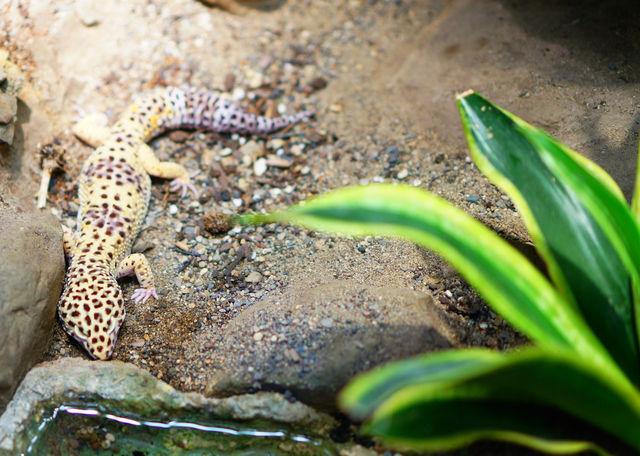At first glance, it’s almost unbelievable that geckos are real, let alone a natural product of evolution.
In spite of their bulging eyes, sticky toes and detachable tail and skins, there’s something so wonderfully, artistically modern in their coloring. The large, duller ones who camouflage almost perfectly with their surroundings seem almost painted into the landscape until you see a head slowly move toward an unsuspecting cricket. The small, bright, vibrant ones have color palettes artists would die for. With these varied and slightly odd-ball reptiles for inspiration, it’s no wonder the Natural History Museum of Utah had such an arts-centric celebration for the opening day of the “Geckos Live!” exhibit on Saturday, Jan. 30.

Giant gecko cut-outs crawled up the main hall’s walls, while on the first floor crafting tables allowed kids and adults alike to draw or make yarn-covered geckos of their own, and a face-painting table featured local artists painting glittery and slightly cartoony versions of the reptiles onto people’s arms and faces. But these were mere stops along the way for a crowd looking to see the real thing upstairs.
“Geckos Live!” is the museum’s latest temporary exhibit and features a variety of geckos from around the world, each kept in climate-controlled glass enclosures intricately designed to mimic the animal’s natural habitats. Hosting as many as six or seven geckos, or as few as one, the pens’ lush foliage, harsh desert landscapes and faux jungle ruins help accentuate the lizards’ ability to blend into their surroundings.
In fact, these exhibits help the lizards so much that a large part of the fun of seeing them is being able to spot the tricky little animals hiding in plain sight. Some, such as the bright green, blue and orange Peacock Day Gecko, are much easier to spot on their leaves than, say, the Chinese Cave Gecko, which lurks in its man-made cave.
Of course, the exhibit isn’t all marveling at the art inherent in nature. Interactive exhibits, like others the museum is known for, find a home in between the main displays themselves. These include small tests using information scattered throughout the descriptions, a game where the player is a predator trying to spot geckos to eat and videos from scientists explaining things such as just what it is about geckos’ toes that let them attach themselves to the walls.
After seeing their fill of these lizards, visitors can move on to the Pigeons display, which uses costumes, taxidermy, skeletons and a video game to detail the evolution of the surprisingly varied bird species. And after that, a museum full of everything from dinosaur fossils to the wonders of what archeology can uncover is available to all visitors.
The museum has the “Geckos Live!” exhibit until May 1. Tickets are free for anyone with a valid UCard.
@Ehmannky


